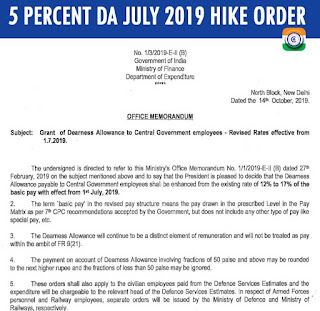Additional Memorandum to 7th Central Pay Commission – IRTSA
13.1. Benefits& Drawbacks of Pay Band and Grade Pay system introduced by 6th CPC
i. Problem of stagnation in pay is eliminated, since pay bands are having long spans.
ii. If employees are stagnated at the maximum of any pay band for more than one year, continuously, he/she shall be placed in the immediate next higher pay band without change in the Grade Pay.
iii. Point to point fixation was facilitated by the pay band system, (with one increment in the revised pay cale for every three increments in the pre-revised scale) – But the employees with more years of service were placed in a disadvantageous position.
iv. Quantum of increment increases exponentially, instead of fixed rate of increment attached to every pay scale – But the difference became very large at higher levels – thus causing discrimination with those at middle & lower levels.
v. Grade Pay decides hierarchy / seniority of the post.
13.2. Main Draw backs of Pay Band and Grade Pay system introduced by 6th CPC
i. Increase between minimum basic pay of prerevised scale and minimum of every Revised Pay Band is not uniform. There is much greater increase in favour of PB-3 & PB-4.
ii. Arbitrary adoption of formula of 40% of maximum of the merged scales for deciding the Grade Pay – instead of progressive and proportionate rise of Grade Pay from one scale to the next.
iii. Disproportionate rise of pay after Sixth Pay commission – due to grant of disproportionate Higher Grade pays in higher scales (S-24 & above) as compared to S-4 to S-23 (Please see details in the following Table and also the table in next page)

iv. Rate of annual increment (3% of basic pay) is inadequate.
v. Increment on promotion (difference in grade pay + one additional increment) is inadequate.
vi. Situation of senior promotes getting less pay than Junior direct recruits, is in violation of basic principle of Pay Band system. For example,
 Source: IRTSA
Source: IRTSA
Pros and Cons of Pay Band and Grade Pay System
Indian Railways Technical Supervisors Association already submitted a
complete memorandum to 7th Pay Commission on 26.5.2014 and Oral
evidence and Power Point Presentation also by IRTSA on 12.12.2014. Now,
an another supplementary Memorandum submitted to 7th Central Pay
Commission on 17.6.2015. The rejoinder memorandum insists on the demands
of Higher Grade Pay and Classification of posts of Technical
Supervisors in Railways.
SUPPLEMENTARY MEMORANDUM SUBMITTED BY IRTSA
TO SEVENTH CENTRAL PAY COMMISSION
TO SEVENTH CENTRAL PAY COMMISSION
Chapter – 13
BENEFITS & DRAWBACKS OF PAY BAND & GRADE PAY SYSTEM INTRODUCED BY SIXTH CENTRAL PAY COMMISSION13.1. Benefits& Drawbacks of Pay Band and Grade Pay system introduced by 6th CPC
i. Problem of stagnation in pay is eliminated, since pay bands are having long spans.
ii. If employees are stagnated at the maximum of any pay band for more than one year, continuously, he/she shall be placed in the immediate next higher pay band without change in the Grade Pay.
iii. Point to point fixation was facilitated by the pay band system, (with one increment in the revised pay cale for every three increments in the pre-revised scale) – But the employees with more years of service were placed in a disadvantageous position.
iv. Quantum of increment increases exponentially, instead of fixed rate of increment attached to every pay scale – But the difference became very large at higher levels – thus causing discrimination with those at middle & lower levels.
v. Grade Pay decides hierarchy / seniority of the post.
13.2. Main Draw backs of Pay Band and Grade Pay system introduced by 6th CPC
i. Increase between minimum basic pay of prerevised scale and minimum of every Revised Pay Band is not uniform. There is much greater increase in favour of PB-3 & PB-4.
ii. Arbitrary adoption of formula of 40% of maximum of the merged scales for deciding the Grade Pay – instead of progressive and proportionate rise of Grade Pay from one scale to the next.
iii. Disproportionate rise of pay after Sixth Pay commission – due to grant of disproportionate Higher Grade pays in higher scales (S-24 & above) as compared to S-4 to S-23 (Please see details in the following Table and also the table in next page)
iv. Rate of annual increment (3% of basic pay) is inadequate.
v. Increment on promotion (difference in grade pay + one additional increment) is inadequate.
vi. Situation of senior promotes getting less pay than Junior direct recruits, is in violation of basic principle of Pay Band system. For example,
a. A JE with five years of service while getting regular promotion from Grade Pay Rs.4200 in PB-2 to Grade Pay Rs.4600 as SSE is fixed at a Basic pay of Rs. 16120 compared to the Direct recruit’s basic pay of Rs.17140.
b. A JE with five years of service while getting promotion (through LDCE) from Grade Pay Rs.4200 in PB-2 to Grade Pay Rs.4800 as AWM/AME/AE is fixed a Basic pay of Rs. 16120 compared to the Direct recruit’s basic pay of Rs.18150.
c. Pay on Promotion should be fixed at least at par with Entry Pay in the Revised Pay Structure for direct recruits.










